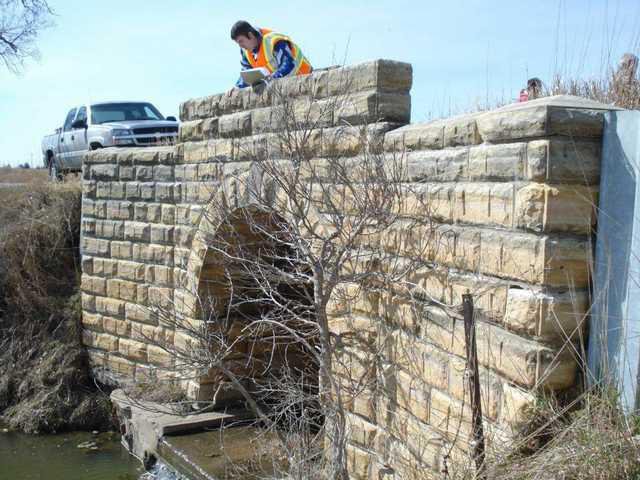BARTON COUNTY — Historic limestone bridges built in the late 1930s and early 1940s by the Works Progress Administration in northern Barton County may once again echo with the sounds of chisels, concrete being poured and reconstruction, as plans are being drawn to repair the old bridges.
Having done their job for 70 years, the bridges, located on township roads, now need to be regrouted, have damaged stones replaced, or be reset. Representatives from Kirkham Michael, the engineering firm that will draw up the plans, the county and the state historical society took a tour of the bridges to gather information for bids on Wednesday.
"Everybody there got a good idea of what needs to be fixed on each bridge," said Clark Rusco, county engineer. The bids will be let out, and it will be up to the Barton County commissioners to decide how much to spend, said Rusco.
Kim Gant, Kansas Historical Society compliance coordinator, was present. According to Gant, the changes and repairs are subject to the state preservation laws because the bridges are on the National Register of Historic Places.
Compression bridges such as the stone bridges are cost efficient only when labor is cost low, said Harry Hunsley III, whose father was employed by Barton County as the county engineer in 1936. He is also an engineer with KM. Hunsley visited the sites as a boy with his father.
Little information is known about the designer of the bridges, but it may have been Harry Hunsley Jr. "I do know my father designed many structures, and therefore I assume some of the designs used during this period were done by him," said Hunsley. "I later worked for Barton County during the summers of 1946-48 and recall many plans, done on linen, for stone arch structures in the file cabinets."
In information Hunsley collected, he said, "The stone arch bridges built throughout north central Kansas during the WPA era were generally built close to the quarry," usually within half a mile of the structure location. For the men working in the mid-1930s, the prevailing wage was a dollar a day for a man, and three dollars a day for a team of mules.
"Since the work at a site would take several weeks to finish, most of the work force lived right at the job site," he said. "Tents were erected, and the men stayed there until the bridge was finished."
The workers drilled the limestone during the winter, and then the holes were filled with water. After the stone fractured from the expansion of the water, the stones were either chiseled into shape at the quarry, or hauled by mule teams and wagons to the site of the bridge.
The chisel marks are still visible on some of the stones.
After quietly doing their job for generations, interest in the bridges was renewed in 2007 when a keystone from one of the bridges fell in the creek during the flooding that occurred that year, sparking the interest of local officials. The keystone has the year 1941 with the initials WPA.
An eighth bridge has been recently rediscovered, the Cleveland Double Arch limestone bridge, found by Rusco.
There are numerous WPA projects in Barton County beside the bridges. Buildings, such as city buildings, band shells, and school lunches number among its projects.
Until ended by Congress during 1943, the WPA was the largest employer in the country. Most people who needed a job were eligible for at least some of its jobs, but the program had its critics at the time.
Indeed, the locations of the bridges do not have a lot to do with practicality.
The WPA was begun in 1935 to provide jobs to the large number of unemployed workers on order by President Franklin Delano Roosevelt. Although they may not have been heavily used, the stone bridges provide interest and historic value to the Byway and a snapshot of the Great Depression era.





